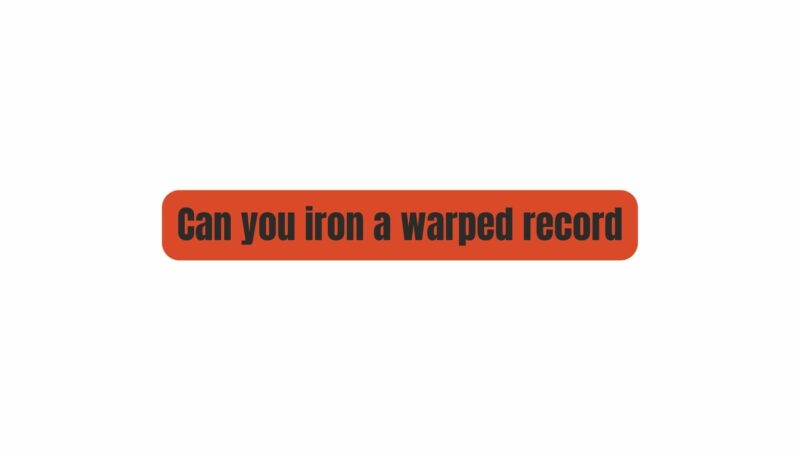Vinyl records, celebrated for their warm analog sound, have seen a remarkable resurgence in popularity. Audiophiles and music enthusiasts around the world appreciate the tactile experience of handling vinyl, from placing the needle on the groove to enjoying the richness of the music. However, vinyl collectors occasionally encounter a vexing problem: warped records. When a vinyl record takes on a wavy or uneven shape, it can lead to audible distortion and playback issues. In the quest to salvage these cherished musical artifacts, one question arises: Can you iron a warped vinyl record? In this article, we explore the concept of ironing warped vinyl records, its risks, and alternative methods to restore them to their original form.
Understanding Warped Vinyl Records
Warped vinyl records are discs that have deviated from their original flat shape, instead taking on a warped or wavy appearance. This distortion can cause playback issues, including audible disturbances and potential damage to both the record and playback equipment.
Causes of Warped Vinyl Records
Several factors can contribute to the warping of vinyl records:
- Manufacturing Defects: Poor quality control during the vinyl pressing process can lead to uneven thickness or distribution of vinyl material, resulting in warping.
- Storage Conditions: Incorrect storage, such as stacking records horizontally or exposing them to excessive heat, can encourage warping over time.
- Environmental Factors: Vinyl records are sensitive to changes in temperature and humidity. Extreme variations can cause the vinyl to expand or contract unevenly, leading to warping.
- Improper Weight Distribution: Storing records with an uneven weight distribution, such as stacking them with heavy objects on top, can promote warping.
Effects of Warped Vinyl Records
Warped records can have several negative consequences:
- Audible Distortion: The most immediate effect is audible distortion during playback. As the stylus navigates the uneven surface, it may produce fluctuations in pitch and speed, resulting in a distorted listening experience.
- Stylus and Groove Damage: Repeated playback on a warped record can accelerate wear and tear on both the stylus and the grooves of the record, potentially causing permanent damage.
- Tracking Issues: Maintaining proper tracking on a warped record can be challenging for the stylus, leading to skips and jumps during playback.
Can You Iron a Warped Vinyl Record?
The idea of ironing a warped vinyl record has been proposed by some as a DIY method to flatten the disc. However, it’s crucial to approach this with caution, as it involves applying heat and pressure to a delicate surface. Here’s a breakdown of the process and its associated risks:
Procedure:
- Materials Needed: You’ll need an iron with a low-heat setting, aluminum foil, and a clean, flat surface.
- Preparation: Place the aluminum foil on the ironing board or any heat-resistant, flat surface. Ensure that the shiny side of the foil is facing up.
- Record Placement: Lay the warped vinyl record on top of the aluminum foil, with the side containing the warping facing upward.
- Ironing: Set the iron to a low-heat setting, and without using steam, gently press it onto the warped section of the record. Move the iron slowly and evenly across the area for a brief duration, typically 10-20 seconds.
- Cooling: After ironing, allow the record to cool while maintaining the pressure until it regains its original shape.
Risks and Considerations:
- Heat Damage: Excessive heat can permanently damage the vinyl. It’s essential to use the lowest possible heat setting and minimize the duration of contact.
- Unpredictable Results: Ironing may not guarantee success in all cases, and the results can vary. Some records may respond better than others.
- Potential for Further Damage: Mishandling or applying too much pressure during the ironing process can worsen the warping or cause additional damage.
- Alternative Methods: Alternative methods for flattening records, such as the use of purpose-built record flattening machines or professional restoration services, may yield more consistent and safer results.
Alternative Methods for Flattening Warped Records
If you are wary of ironing your vinyl records or prefer a more reliable approach, consider these alternative methods:
- Record Flattening Machines: These machines are designed specifically for flattening vinyl records. They use controlled heat and pressure to gradually restore the record’s flat shape without risking damage.
- Professional Restoration: For valuable or severely warped records, consulting a professional vinyl record restoration service is a prudent choice. Experts can employ specialized equipment and techniques to address warping effectively.
- Prevention: The best way to deal with warped records is to prevent them from occurring in the first place. Store your vinyl collection vertically in a cool, dry, and stable environment, avoiding direct sunlight and extreme temperature fluctuations.
Conclusion
Warped vinyl records can be a frustrating challenge for collectors, but the approach of ironing them should be met with caution due to the potential risks and unpredictable outcomes. While ironing may work in some cases, it is not a foolproof method and may lead to irreversible damage if not done carefully.
To preserve your cherished vinyl collection and ensure optimal playback, consider alternative methods such as record flattening machines or professional restoration services. Moreover, focusing on prevention through proper storage practices is the key to maintaining the longevity and quality of your vinyl records. In the end, the magic of vinyl lies in its ability to deliver a timeless musical experience, and by taking the right measures, you can continue to enjoy your vinyl records for years to come.


